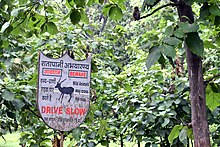The Ratapani Tiger Reserve, located in the Raisen district of Madhya Pradesh,[3] in Vindhya Range in central India, is one of the finest teak forests in the state and is less than 50 kilometres (31 mi) away from the capital Bhopal. The reserve is rich in flora and fauna and a wide variety of birds and mammals. It has been a wildlife sanctuary since 1976. It was declared as a tiger reserve in 2024.[4][5]
History
Ratapani was declared as a wildlife sanctuary 1976.[6] In accordance with the directives issued by Chief Minister Mohan Yadav in December 2024, the Ratapani forest has been designated as the eighth tiger reserve in the state.[2]
Geography

The Ratapani Tiger Reserve is located in Raisen district of Madhya Pradesh. It encompasses a total area of 1,271.465 square kilometres (490.915 sq mi), which includes a core area of 763.812 km2 (294.909 sq mi) and a buffer zone of 507.653 km2 (196.006 sq mi).[2] The landscape is undulating, with hills, plateaus, valleys and plains. A number of seasonal streams irrigate the site in the monsoon, and water is retained in some pools along these streams even in the summer. Two large reservoirs, namely Barna Reservoir and Ratapani Dam (Barrusot lake) are among the major waterbodies adjacent to or inside the sanctuary. Bhimbetka rock shelters, are located within this tiger reserve. These rock shelters were inhabited by man hundreds of thousand years ago and some of the rock paintings of the Stone Age are more than 30,000 years old. It has been declared a World Heritage Site by UNESCO.[7]
Flora

The forest of Ratapani is dry deciduous and moist deciduous type, with teak (Tectona grandis) as the main tree species. About 55% of the area is covered by teak. The remaining mixed forests consist of various dry deciduous species. Bamboo (Dendrocalamus strictus) overlaps the two aforementioned forest types and covers about one quarter of the forest area.[7]
Fauna
A large variety of wildlife is found in the wildlife sanctuary. Some precipitous hills have cliffs; have large rock blocks and talus at the base. This unique feature provides shelter to various animals like vultures, reptiles and small mammals.
Carnivores in the sanctuary include the tiger, leopard, dhole, hyena, jackal and fox, and the herbivores include chital, sambar, nilgai, four-horned antelope, langur and wild boar, and primates: langur and rhesus macaque. The omnivorous sloth bear is also seen often. Smaller animals, like squirrels, mongooses, gerbils, porcupines, hares, etc. are of common occurrence. Among reptiles, important species include different kinds of lizards, chameleon, snakes, etc. Among snakes, cobra, python, viper, krait, etc. are common.[7]
In February 2019, a tiger found in the area of Lunavada in Mahisagar district of Gujarat State,[8][9] before being spotted dead,[10] was said to have come from this sanctuary.
Bird
The Ratapani WLS is rich in the typical wildlife of central India. More than 150 species of birds are seen here. A few to mention are the common babbler, crimson-breasted barbet, bulbul, bee-eater, baya, cuckoo, kingfisher, kite, lark, Bengal vulture, sunbird, white wagtail, crow pheasant, jungle crow, egrets, myna, jungle fowl, parakeets, partridges, hoopoe, quails, woodpeckers, blue jay, dove, black drongo, flycatcher, flower pecker and rock pigeon.[7]
Oriental white-backed vulture (Gyps bengalensis), long-billed vulture (Gyps indicus) and red-headed vulture (Sarcogyps calvus) are often found perched on a cluster of tree. The Ratapani dam at the periphery of the sanctuary invites thousands of migratory birds in winter. There are many smaller reservoirs dotted all over the sanctuary. The total waterfowl populations in all these smaller reservoirs and Ratapani reservoir would easily exceed 20,000 (A4iii criteria). Moreover, these waterbodies also attract large wading birds such as the sarus crane (Grus antigone), painted stork (Mycteria leucocephala), black-necked stork (Ephippiorhynchus asiaticus) and white-necked stork (Ciconia episcopus).
Ratapani retains some of the finest representative forest cover of the Indo-Malayan Tropical Dry Zone (Biome-11). Of the 59 bird species identified by BirdLife International (undated) in this biome, 33 are found in Ratapani, further proving the importance of this site for the protection of biome species. Detailed studies could reveal more bird species.[11]
Threats
- Poaching
- Encroachment and forest fires
- Illicit felling
- Livestock grazing
- Man-animal conflict

This large sanctuary faces pressures from all directions. Illicit felling, grazing by cattle, poaching and encroachment are the major concerns for the management. Presence of 26 villages inside the sanctuary and another 109 villages around it exert the associated anthropogenic pressures. These villages are dependent for their day-to-day needs on the biomass resources of the sanctuary. Forest fires, natural and man-made, are a major problem in summer. The long, narrow area of Ratapani WLS(about 70 km long and about 15 km wide) makes it more vulnerable to intensive biotic pressure in most of its areas.[12]
References
- ^ "Kheoni". protectedplanet.net.
- ^ a b c "Ratapani forest notified as eighth tiger reserve in Madhya Pradesh". Deccan Herald. Retrieved 4 December 2024.
- ^ "About Ratapani (Archived copy)". Archived from the original on 2014-10-06. Retrieved 2014-10-03.
- ^ "Press Information Bureau".
- ^ "Madhya Pradesh gets its eighth tiger reserve in Ratapani". The Indian Express. 3 December 2024. Retrieved 4 December 2024.
- ^ "Milestone Initiatives:National Tiger Conservation Authority / Project Tiger". Archived from the original on 2015-05-30. Retrieved 2015-06-10.
- ^ a b c d Tiwari, S.K (1997). "Ratapani Sanctuary". Wildlife Sanctuaries of Madhya Pradesh. APH Publishing Corporation. pp. 91–96. ISBN 9788170248101.
- ^ "Like humans, animals too have a right to migrate". The Hindustan Times. 2019-02-18. Retrieved 2019-03-17.
- ^ Ghai, Rajat (2019-02-12). "Camera trap proves Gujarat now has tiger". Down To Earth. Retrieved 2019-03-17.
- ^ Kaushik, Himashu (2019-03-09). "Tiger that trekked from MP to Gujarat died of starvation: Post-mortem report". The Times of India. Retrieved 2019-03-17.
- ^ [1]
- ^ [2]








